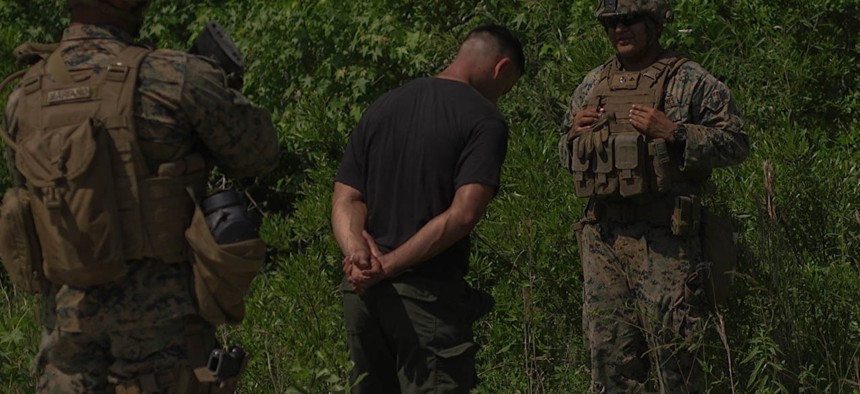
U.S. Marine Corps Lance Cpl. Ulysses Sebastian Brindiz, a military policeman with 2nd Law Enforcement Battalion (LE Bn), II Marine Expeditionary Force, Information Group tactically questions a detainee during an exercise in LZ Phoenix, N.C., May 18, 2019. U.S. Marine Corps photo by Sgt. Luisa Torres
Special Operations Command Made a Mind-Reading Kit For Elite Troops
The experimental tool is among several that aim to combine sensors and AI to give U.S. operators a new edge.
TAMPA, Florida — As tomorrow’s elite soldiers work to persuade local populations to support them, they may be able to sense how their messages are being received by detecting invisible biometric signals. Or when pinned down by enemy fire, they may make hand gestures to designate targets for close air support, or operate swarms of drones with just a few voice commands.
Those were just a few of the superhuman abilities that researchers at U.S. Special Operations Command recently showed off in a series of demonstrations that brought together sensors, data, and AI, SOFWERX chief technology officer Brian Andrews said Tuesday at Defense One’s Genius Machines event here. SOFWERX is a prototyping and innovation partnership run by SOCOM and a non-profit company called DEFENSEWERX.
In August, SOFWERX researchers combined a special glove with software and hardware from Boston-based Pison Technologies. Within a few hours, a test subject was able to make subtle movements in the air to manipulate a virtual tactical air control map. “When I flick my finger, it picks up the nerve impulse from the magnetic field,” said Andrews, referring to the small amounts of electricity used by the brain to trigger muscle movement.
SOFWERX is also building a sensor-embedded “autonomous bio-infused treatment shirt” that could provide detailed biophysical feedback about the condition of soldiers on the battlefield. “It can even tell if you get shot. It will send to the medic what your vital signs are, respiratory rate, pulse rate,” said Andrews. They’re also moving ahead with new forms of voice command for drones.
Related: Special Operations Command Is Experimenting With Bullets That Shoot Through Water
Related: Here’s How Google Pitched AI Tools to Special Operators Last Month
Related: The Air Force Will Start Work on Flying Cars This Fall
Earlier this month, SOFWERX tested a “physiological analysis tool” designed to help troops understand, in real time, how foreigners are receiving or interpreting their messaging, information, and psychological operations.
“We pulled together quite a few sensors, Andrews said. “Through radars, through video, you can tell heart-rate variability. You can get temperature from [the subject’s] body. You can do voice analysis” to detect how, for instance, a conversational partner feels about the information an operator is giving them.
SOCOM and 15 partners “pulled it together in about a week but we were fairly successful,” he said. “We put a test guy up there [and] asked him some questions that made him fairly uncomfortable. Now, getting ‘intent’ is hard; but we could tell: ‘Hey, this person is nervous when you ask this question. Their countenance changed.’ Micro-expressions is another way to look at this.”
They tested a scenario that put a soldier in a village where ISIS has been busily recruiting. As the operator talks to village elders, the system collects and interprets data. In real time, or later (so as not to be a distraction), the system indicates whether the villagers received the message and whether they viewed the messenger favorably, regardless of what they were saying.
The Hyperenabled Operator
Andrews’s experiments speak to — but are not officially a part of — a broad new research effort that SOCOM announced in May. Dubbed the Hyper-Enabled Operator Concept, the idea is to develop capabilities for troops and commanders in four key areas: human-machine interaction, data, applications, and communications, including in contested environments.
Former SOCOM commander Tony Thomas first broached the idea of combining artificial intelligence and sensors to give operators an edge back in 2016. There were a lot of details to work through: What data would be relevant to commanders, to operators? What should the operator be in charge of and what should the software handle? The Hyper-Enabled Operator Concept was borne out of the recently concluded TALOS, or Iron Man, program. Endowing soldiers with super physical abilities did not work out so well. But researchers realized that there was a lot of potential to use data and information technology to create new cognitive abilities.
SOCOM is forming a joint acquisition task force for the program, according to Michelle Popke, deputy head of the organization's Command Data Office. In the months ahead, that task force will consult with the service components within SOCOM, such as the Navy SEALS, the Army Rangers, etc. to figure out their needs for human-machine interaction, data, applications, and communications. Then the task force will match those needs to new research or existing technology. The concept will “inform a lot of other SOCOM programs of record,” she said.
Beyond that, SOCOM wants AI to help commanders better understand the battlefield. Popke said the command recently approved a requirements document to define the future of mission command. “Project Maven has an initiate for AI-enabled mission command. We’re doing some combat evaluations with some of our forward deployed now,” she said.
Popke also said that the SOCOM’s efforts would comport “100 percent” with the new ethical guidelines for using AI produced by the Defense Innovation Board.





